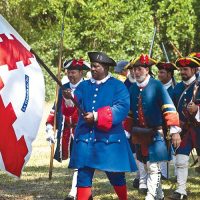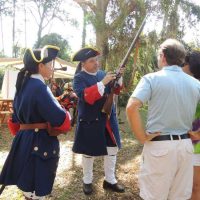Fort Mose Historic State Park
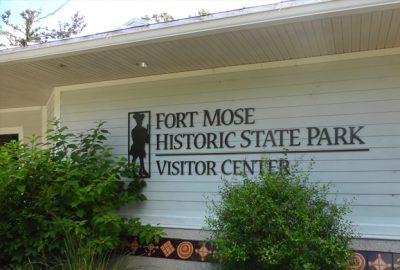
Fort Mose Historic State Park is the site of the first legally sanctioned free African settlement in what is now the United States. In 1738, the Spanish governor of Florida chartered the settlement of Gracia Real de Santa Teresa de Mose, or Fort Mose for short, as a settlement for those fleeing slavery from the English colonies in the Carolinas. Over the next 25 years, Fort Mose and Spanish Saint Augustine became a sanctuary for Africans seeking liberation from the tyranny of English slavery.
Fort Mose has been recognized for its national significance in commemorating the history of the United States. In 1994 the site was designated as a National Historic Landmark and was listed on the National Register of Historic Places. In 2009 the National Park Service named Fort Mose as a precursor site on the National Underground Railroad Network to Freedom.
Although there are no remains of the earth and wooden structures, visitors can still view the land where the settlement once stood. Stroll down the sun-drenched boardwalk and imagine life in the eighteenth century. Learn more about the story of Fort Mose in our newly constructed visitor center and museum or explore the grounds and view one of the many exhibits available.
LOCATION
MAKE IT A NIGHT
ALBUQUERQUE LITTLE THEATRE
 Cheese Coffee Caf Downtown
Cheese Coffee Caf Downtown  Liu Chinese Fast Food
Liu Chinese Fast Food  Vinaigrette
Vinaigrette Garcias Kitchen The Original
Garcias Kitchen The Original  Route 66 Malt Shop
Route 66 Malt Shop  Bottger Mansion of Old Town
Bottger Mansion of Old Town
 Bottger Mansion of Old Town
Bottger Mansion of Old Town Liu Chinese Fast Food
Liu Chinese Fast Food
 Bottger Mansion of Old Town
Bottger Mansion of Old Town  Liu Chinese
Liu Chinese Vinaigrette
Vinaigrette
Contact information
Featured Venues
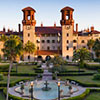 With sparkling crystal chandeliers, intricate mosaic tile flooring, majestic arched windows, and carved wooden staircases, Lightner Museum is a show-stopper! The museum opened in 1948, displaying the collections of Otto C. Lightner, which include 19th-century artwork, glassware, sculpture, furniture, stained glass, and antique chandeliers throughout the three floors of exhibits. Originally built as the Hotel Alcazar in 1888 by Standard Oil co-founder Henry Flagler, this beautiful structure was created in the Spanish Renaissance Revival Style. In addition to the Lightner Museum, it also houses St. Augustine City Hall, several antique shops, and Cafe Alcazar, a restaurant that sits in the location of what was once the world’s largest indoor swimming pool.
With sparkling crystal chandeliers, intricate mosaic tile flooring, majestic arched windows, and carved wooden staircases, Lightner Museum is a show-stopper! The museum opened in 1948, displaying the collections of Otto C. Lightner, which include 19th-century artwork, glassware, sculpture, furniture, stained glass, and antique chandeliers throughout the three floors of exhibits. Originally built as the Hotel Alcazar in 1888 by Standard Oil co-founder Henry Flagler, this beautiful structure was created in the Spanish Renaissance Revival Style. In addition to the Lightner Museum, it also houses St. Augustine City Hall, several antique shops, and Cafe Alcazar, a restaurant that sits in the location of what was once the world’s largest indoor swimming pool.
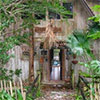 Beluthahatchee Park is a four-acre park located within the 70-acre tract of land purchased by Stetson Kennedy in 1948 after the 18-acre Beluthahatchee Lake was created by impounding Mill Creek in 1945. This lake meanders through a natural basin and is surrounded by high bluffs, currently owned by the Lake Dwellers Association, a non-profit Florida corporation formed by the lakefront residents. In 1949, the 70-acre tract was subdivided and platted by the owner/developer Stetson Kennedy who recorded the restrictive covenants setting aside land in perpetuity as a wildlife refuge, and stipulating that residential construction be consistent with the developer’s goal of “serving as a working demonstration that human and natural habitat need not be mutually exclusive, but can coexist in harmony.”
Beluthahatchee Park is a four-acre park located within the 70-acre tract of land purchased by Stetson Kennedy in 1948 after the 18-acre Beluthahatchee Lake was created by impounding Mill Creek in 1945. This lake meanders through a natural basin and is surrounded by high bluffs, currently owned by the Lake Dwellers Association, a non-profit Florida corporation formed by the lakefront residents. In 1949, the 70-acre tract was subdivided and platted by the owner/developer Stetson Kennedy who recorded the restrictive covenants setting aside land in perpetuity as a wildlife refuge, and stipulating that residential construction be consistent with the developer’s goal of “serving as a working demonstration that human and natural habitat need not be mutually exclusive, but can coexist in harmony.”


